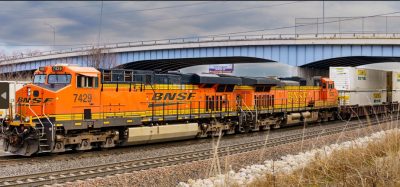One year on: high-speed plans continue
Posted: 26 September 2007 | | No comments yet
In our last article (published in ERR 4/06) concerning the plans, projects and priorities of REFER, we presented a general perspective of the public infrastructure investment in the conventional network corresponding to the most urgent ones and it also gave some information about the development of the high-speed project. Approximately one year later, with the high-speed project stabilized and fulfilling its schedule, namely the public presentation of its financial model in July, REFER is now able to present the latest developments of its investment program 2007/2015 regarding the conventional network.
In our last article (published in ERR 4/06) concerning the plans, projects and priorities of REFER, we presented a general perspective of the public infrastructure investment in the conventional network corresponding to the most urgent ones and it also gave some information about the development of the high-speed project. Approximately one year later, with the high-speed project stabilized and fulfilling its schedule, namely the public presentation of its financial model in July, REFER is now able to present the latest developments of its investment program 2007/2015 regarding the conventional network.
In our last article (published in ERR 4/06) concerning the plans, projects and priorities of REFER, we presented a general perspective of the public infrastructure investment in the conventional network corresponding to the most urgent ones and it also gave some information about the development of the high-speed project.
Approximately one year later, with the high-speed project stabilized and fulfilling its schedule, namely the public presentation of its financial model in July, REFER is now able to present the latest developments of its investment program 2007/2015 regarding the conventional network.
The Government investment program was presented on the 28 October 2006, the date of the 150th anniversary of the railway in Portugal, consisting of the ‘Strategic Railway Guidelines’ targeting the year 2015. This document is very important to REFER, and to the entire railway sector, because it allows to plan the investments and to organize and structure the railways companies.
For a better understanding of the implications of the ‘Strategic Railway Guidelines’ on the railway infrastructures investment plan we hereby present a brief resume of the main items. Objectives established:
- To increase the railway market share through the improvement of the accessibility and the mobility
- To guarantee and maintain high network standards of safety, cross border operability and environmental issuesTo evolve to a financially self sustained model and more efficient one.
- Main targets to achieve until 2015:
- Increasing of 10% on the number of passengers and passenger kilometres
- Increasing of 60% on the gross tonnes and 70% of the gross tonne kilometres
- Reduction of 60% on the accidents in level crossings
- Reassess the REFER Investment Plan having in mind:
- The construction of the High Speed Train Network
- The location of the logistic platforms (set up by the Government in ‘Portugal Logistico’), the ports, the airports, main borders and other merchandise concentration points
Until now, the review of the REFER Investment Plan, which is being developed almost at the same time as the QREN 2007/2013 (a multiannual strategical planning of economic development that integrates European funds), is pointing towards an investment of €3,350 million, for the period 2007/2015.
This investment plan will be included in the Multi-annual Contract that REFER is currently preparing to present to the State, as mentioned in the last article, establishing a new and more transparent relation between REFER and the State.
Major investments included in the REFER Investment Plan 2007/2015
Third Bridge Crossing over Tagus river on the corridor Chelas/Barreiro (Third Tagus Crossing – TTC)
Though the Third Tagus Crossing is part of the High Speed Network project in its Lisbon/Madrid connection, REFER will develop its conventional network in this corridor as well, since it will allow additional capacity in the connection between North and South of Portugal, overcoming current restrictions that occur in the 25 de Abril Bridge Crossing. From 2013 on, this new connection will allow the reorganization of the suburban trains, the reduction of 30 minutes in the Lisbon/Algarve connection, and a better service for freight trains starting or ending in Lisbon. A total amount of approximately €660 million will be invested in this bridge crossing.
Northern Line
The Northern Line is the most important line of the conventional network; its modernisation is finished in 2/3 of its extent (336km). As it was established in the ‘Strategic Railway Guidelines’, the modernisation of the Northern Line must be completed, in order to improve safety and reliability and to achieve a regular speed of 160 km/h.
Having in mind the High Speed Lisbon/Oporto Line and the transfer of the faster trains service from the conventional line to the high speed line, there will be a greater capacity in the conventional line that will allow the development of the suburban, regional and freight trains, in accordance to what happened in other European countries.
This project includes the removal of all level crossings and the setting up of electronic signalling. The total amount of the investment is about €425 million and it should be finished in 2012.
Álcacer Alternative Track (Variante de Álcacer)
The purpose of this alternative track in the Lisbon/Faro Line, with a length of 29km, is to increase the speed limit to 220km/h, reducing the travel time of the fast trains that connect Lisbon and Oporto with the touristic region of Algarve in 10 minutes. This project has already started and it should be concluded by 2010, June; the investment amount is €145 million.
Beira Baixa Line
This Line has been modernised between Entroncamento and Castelo Branco. The investment project considers the modernisation on the remaining part of this line: electrification and electronic signalling between Castelo Branco and Guarda (113km); renewal of the track between Covilhã and Guarda (41km); removal of level crossings; and refitting of some stations. The total amount of the investment is €185 million and it should be finished by the end of 2011.
Port of Sines/Évora/Elvas/fronteira portuguesa
This is a strategical investment for Portugal: its purpose is to establish the connection between the Port of Sines and Spain, and the rest of the Europe, naturally, for the freight traffic. Its extension is 220km and it will be invested a total amount of €750 million.
This line is part of corridor nº 16 of RTE-T, which shows its importance for Europe. This line will guarantee cross border operability through ERTMS level 1 and multipurpose sleepers that will allow the changing of the track gauge. The first stage will accomplish 180km and should be finished in 2013.
Metropolitan area of Lisbon
In this area, the REFER Investment Plan assigns an amount of €350 million. The market share of the railway in the suburban transport is quite significant and there are very important projects for the suburban railway traffic: in the Sintra Line, the stations of Barcarena and Cacém will be modernised, the track between them will be doubled, and the tunnel of Rossio, that has been closed since 2004 for safety reasons creating a lot of traffic difficulties, will be opened this year; in the Cascais Line, it is being prepared a vast modernisation project that aims to reverse the decreasing trend of the suburban traffic.
Access to Ports and Logistic Platforms
In addition to the Port of Sines/Évora/ Elvas project mentioned above, the REFER Investment Plan involves: the construction of the railway access to the Port of Aveiro and to its logistic platform (in the north of the country) until the end of 2009, adding up to €85 million; and other railway accesses to other logistic platforms with an investment amount of €90 million.
Metropolitan area of Oporto
The projects considered in this area are closely related to the high speed projects Lisbon/Oporto and Oporto/Vigo. Its purpose is to increase the conventional network capacity, allowing on a first stage the exploitation of the conventional network by the high speed service on the connection Oporto/Vigo. The total amount of the investment is about €60 million. It has already started the construction of an alternative track in the Minho Line, with a length of 3.6km, that will be finished in 2010.
The elimination of level crossings is another essential project for REFER, since one of the major targets established by the ‘Strategic Railway Guidelines’ is the reduction of 60% on the accidents in level crossings. Level crossings will be removed in accordance to the analysis of risk of accident of each level crossing, obviously being given priority to those with greater level of risk.
In addition to these major investments, there are several other projects still in a preliminary stage, like the Algarve Line and the West Line.
This is a very ambitious investment plan and REFER is especially committed to accomplish it. REFER believes that in the end of this new investment cycle in the conventional and in the high speed network infrastructure, the railway sector will be much more competitive, contributing to the Government objective of a sustainable development of the economy.
About the author
José Alves Monteiro is a graduate Civil Engineer from Instituto Superior Técnico (Lisbon) since 1982. He joined the railway sector (CP) in 87. With the reorganization of the Portuguese railway sector in 97, he began to work in the new infrastructure manager (REFER). He was member of the board of RAVE (2001/2002). Since 2006 Alves Monteiro holds the position of Director-General of Planning and Strategic Control of REFER.








